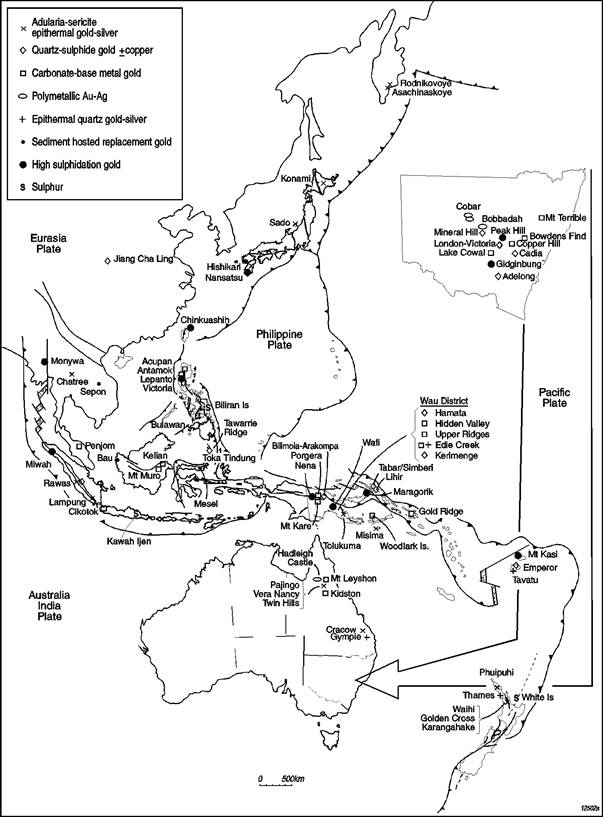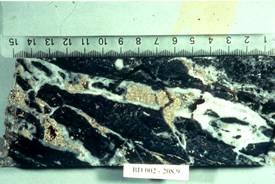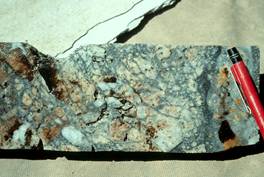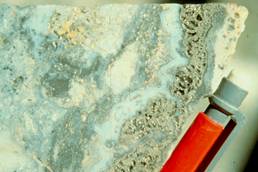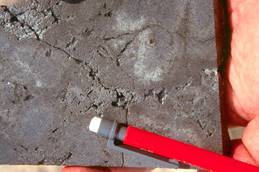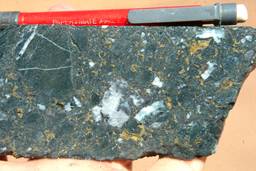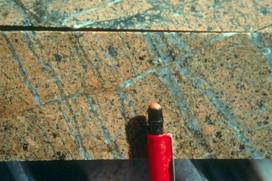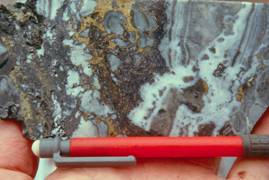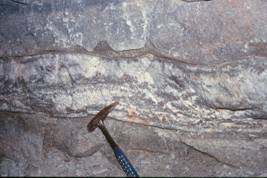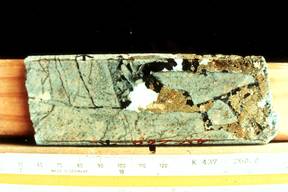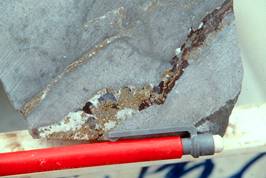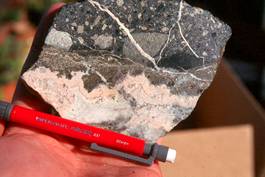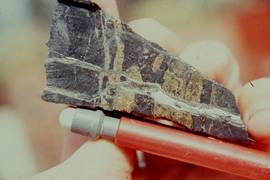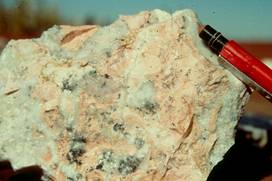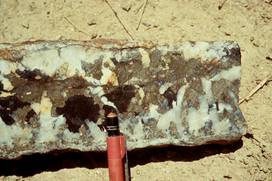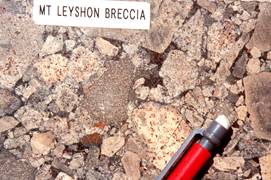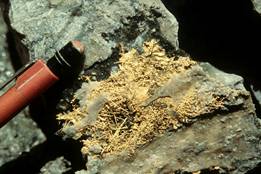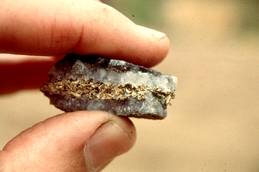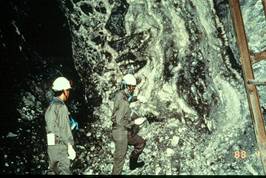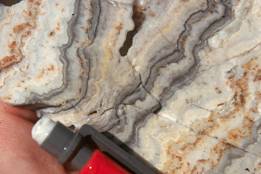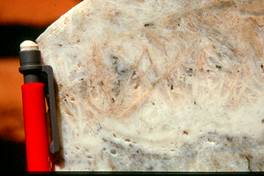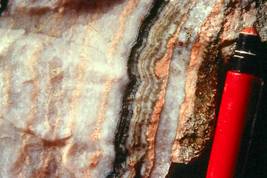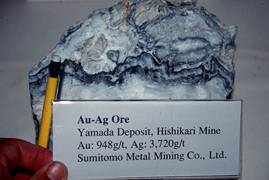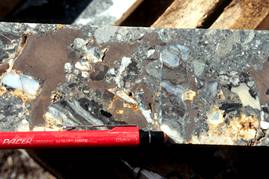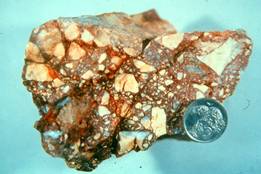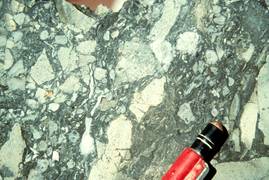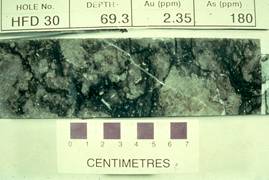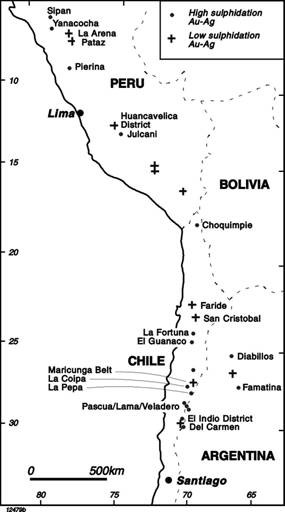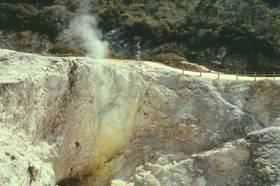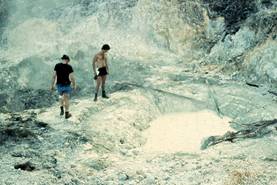
Greg Corbett, Consultant Geologist
AIG Presidential Lecture 2001-2002
Click here to download paper as PDF
ABSTRACT
Epithermal gold (± Cu & Ag) deposits form at shallower crustal levels than porphyry Cu-Au systems, and are primarily distinguished as low and high sulphidation using criteria of varying gangue and ore mineralogy, deposited by the interaction of different ore fluids with host rocks and groundwaters. Low sulphidation deposits are in turn further divided according to mineralogy related to the depth and environment of formation, while high sulphidation systems vary with depth and permeability control, and are distinguished from several styles of barren acid alteration.
Low sulphidation epithermal Au + Cu + Ag deposits develop from dilute near neutral pH fluids and are divided into two groups: those which display mineralogies derived dominantly from magmatic source rocks (arc low sulphidation), and others with mineralogies dominated from circulating geothermal fluid sources (rift low sulphidation). The former are classed with decreasing crustal level as: quartz-sulphide gold + copper, passing to polymetallic gold-silver veins, carbonate-base metal gold and shallowest epithermal quartz gold-silver. These ore types are zoned in time and space with shallower styles overprinting the deeper, and metal contents which vary as high Cu at depth, to Ag and Au dominant in elevated crustal settings. Low sulphidation adularia-sericite epithermal gold-silver systems comprise the rift low sulphidation style. These are dominated by gangue mineralogies deposited from meteoric water rich circulating geothermal fluids, typically formed in rift settings. Sediment hosted replacement gold deposits are interpreted to develop from low sulphidation fluids in reactive carbonate bearing rocks.
High sulphidation Au + Cu ore systems develop from the reaction with host rocks of hot acidic magmatic fluids to produce characteristic zoned alteration and later sulphide and Au + Cu + Ag deposition. Ore systems display permeability controls governed by lithology, structure and breccias and changes in wall rock alteration and ore mineralogy with depth of formation. One of the challenges is to distinguish the mineralised systems from a group of generally non-economic acidic alteration styles including lithocaps or barren shoulders, steam heated, magmatic solfatara and acid sulphate alteration.
INTRODUCTION
This paper is a work in progress based upon my experiences in the exploration for, and evaluation of, magmatic arc epithermal gold and porphyry copper-gold deposits (Figure 1). It therefore draws upon, and updates, recent studies (Corbett and Leach, 1998; Corbett, 2001a & 2001b). This review focuses upon the essential features of the different styles of epithermal gold deposits illustrating them with many examples, and suggests some implications of the characteristics of each style the explorationist should consider.
In 1980 I began preparation of a geological map of a then little known prospect called Porgera in Papua New Guinea, but at the time could not reconcile my field observations on the style of mineralisation with the published literature. Although at that time porphyry copper deposits were well described, only the rise in the price of gold prompted the exploration boom and eventual expanded database for epithermal gold deposits. I have used a relatively empirical approach focusing upon the comparison of field characteristics of as many systems as possible, in the on going development of a classification, which could then form the basis of genetic models, Corbett and Leach (1998). Porgera turned out not to be unique, and was eventually classified as part of the group of deposits which are the major gold producers in the SW Pacific rim – Carbonate-base metal gold deposits (Leach and Corbett, 1994; Corbett et al., 1995). Only by knowing what type of deposits we are dealing with, can explorationists evaluate the economics of any project, and importantly, search for more ore.
Figure 1. Some projects in the southwest Pacific discussed in this review
CLASSIFICATION
Crustal level and ore fluid characteristics provide the first and second order distinctions in the classification of Pacific rim magmatic arc gold deposits (Figures 2 & 3; Corbett and Leach, 1998 and references therein).
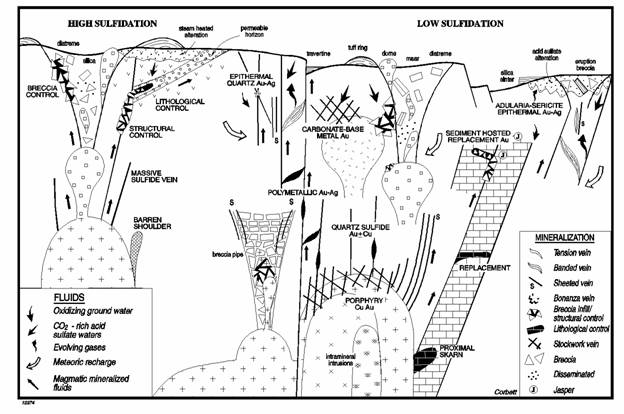
Figure 2. Conceptual model for styles of magmatic arc epithermal Au-Ag
and porphyry Au-Cu mineralization
Most explorationists regard epithermal gold deposits as those formed at higher crustal levels than porphyry environments, although many are telescoped upon deeper porphyry systems. Original definitions (Heald et al., 1987) suggest that epithermal deposits formed at temperatures < 300°C and therefore at elevated crustal settings, typically < 1 km. Some deposits described as ‘epithermal’ formed at relatively high temperatures and deep crustal levels (e.g., Kelian, Corbett and Leach, 1998), and so could fall into the mesothermal category of Lindgren (1922). However, the term mesothermal is not used here in order to avoid confusion with slate belt or lode deposits to which it is generally applied. Some low sulphidation quartz-sulphide gold ± copper formed as deeper crustal levels are transitional to porphyry Cu-Au systems (e.g., the Cadia, Maricunga Belt), which are locally termed wall rock porphyry deposits by some workers. Thus, there is a transition between porphyry and epithermal gold deposits, particularly in low sulphidation systems.
The term epithermal is therefore used in field exploration studies to describe Au ± Ag ± Cu deposits formed in magmatic arc environments (including rifts) at elevated crustal settings, most typically above the level of formation of porphyry Cu-Au deposits (typically < 1 km), although in many instances associated with subvolcanic intrusions. Higher level epithermal deposits are commonly formed later in a deposit paragenesis, and may be telescoped upon deeper earlier formed deposits, including in some instances porphyry systems which are older, or part of the same overall magmatic event (e.g., Lihir, Corbett et al., 2001). In strongly dilational structural environments porphyry-related systems may be telescoped outwards into the deeper ‘epithermal’ environment (e.g., Cadia, Maricunga Belt).
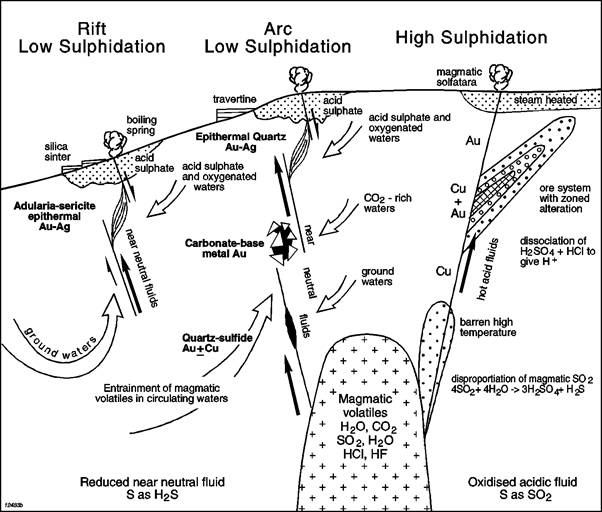
Figure 3. Derivation of low and high sulphidation fluids including arc and rift low sulphidation.
Adapted from Corbett (2001) and Corbett and Leach (1998).
The secondary classification of magmatic arc epithermal gold deposits is between high and low sulphidation, distinguished by characteristic ore and gangue mineral assemblages which are derived from two varying fluid types and display differing paths of fluid evolution (Corbett and Leach, 1998 and references therein). Here, I focus upon the field characteristics of these deposit types.
LOW SULPHIDATION GOLD-SILVER ± COPPER DEPOSITS
Low sulphidation epithermal gold deposits are derived from reduced, near neutral pH, dilute fluids developed by the entrainment of magmatic components within deep circulating groundwaters, and are characterised by sulphur species reduced to H2S (Corbett and Leach, 1998 and references therein). Hydrothermal fluids become progressively more diluted by the incorporation of increased quantities of ground waters during migration further from the intrusion heat (and magmatic component) source, to higher crustal levels. The classification developed mainly using SW Pacific examples (Corbett and Leach, 1998), and expanded upon here, describes a series of deposit styles as end points within a continuum, where many individual ore systems (deposits) may contain several of the deposit styles developed during ore fluid evolution, or by telescoping, and repeated mineralisation. Telescoped systems generally display later formed mineralisation typical of higher crustal levels overprinting deeper earlier formed mineralisation. The majority of ore deposition is promoted by fluid cooling aided by rock reaction, and mixing of rising ore-bearing fluids with groundwaters. Contrasting groundwater types and varying crustal levels contribute towards mineralogical differences used to categorise the styles of low sulphidation epithermal gold deposit styles (Corbett and Leach, 1998).
The third order in the classification of low sulphidation epithermal gold deposits (Figures 1 & 2) is expanded from the terminology used to distinguish SW Pacific examples (Corbett and Leach, 1998), to account for mineralogies which result from varying associations with magmatic source rocks and input of meteoric geothermal waters, termed arc and rift low sulphidation.
The Arc Low Sulphidation gold deposits display strong field associations with intrusive rocks and are catagorised below on the basis of varying ore (pyrite, sphalerite, galena, chalcopyrite, arsenopyrite), gangue (quartz, carbonate, clay) and wall rock (clay, chlorite) mineralogies, which essentially relate to formation at increasingly shallow crustal levels as: quartz-sulphide gold ± copper, polymetallic gold-silver [a new class], carbonate-base metal gold, epithermal quartz gold-silver. The Rift Low Sulphidation deposits comprise the adularia-sericite epithermal gold-silver ores in the classification of Corbett and Leach (1998), and typically occur as veins with gangue mineralogies (chalcedony, adularia, quartz pseudomorphing platy carbonate) deposited from circulating dilute (meteoric-dominated) geothermal waters, within dilatant structures, typically confined to rifts within magmatic arcs or back arc environments.
A locally recognised transition between rift and arc low sulphidation, may more rarely continue further as a transition between arc low sulphidation and high sulphidation, broadly speaking as the ore fluid displays an increased dominance of the intrusion component rather than derivation from meteroric-dominated geothermal fluids, which form the rift low sulphidation (adularia-sericite) gold deposits. Note the term epithermal is not incorporated in the names of the deeper arc low sulphidation styles (quartz- sulphide gold ± copper, polymetallic gold-silver, and carbonate-base metal gold), which in some instances form at greater depths than would be expected for epithermal gold deposits.
ARC LOW SULPHIDATION ‘EPITHERMAL’ GOLD DEPOSITS
The Arc low sulphidation gold deposits display associations with intrusion rocks and are categorised with increasing distances from the inferred magmatic source and hence shallower depths (Corbett and Leach, 1998), and expanded upon herein, as:
Quartz-sulphide gold ± copper
Quartz-sulphide gold ± copper deposits, which form at deepest crustal levels close to porphyry intrusions, comprise dominantly iron sulphides and quartz, mostly as veins and vein/breccias. Iron sulphide most commonly comprises pyrite (e.g., Bilimoia, Photo 1), but locally pyrrhotite in hotter conditions at deeper levels (e.g., Kelian, Jez Lode at Porgera), and arsenopyrite (e.g., Kerimenge, Photo 2), grading in cooler conditions of formation at higher crustal levels to marcasite (e.g., Rawas, Photo 3) and arsenean pyrite (e.g., Lihir, Photo 4). Quartz-sulphide fluids cooled at high level epithermal settings my exhibit anomalous As, Hg and Sb (e.g., Gulbadi, Tolukuma).
Copper may occur as chalcopyrite in systems formed at deeper crustal levels, and anomalous bismuth is common (e.g., Mineral Hill, Photo 5), while some galena and sphalerite may occur at higher levels (e.g. Kidston) transitional to carbonate-base metal gold or polymetallic gold-silver deposits. Quartz is typical in most veins, although within strongly alkaline silica poor (shoshonitic) rocks, K feldspar may dominate (e.g., Lihir, Simberi). Crystalline comb quartz predominates in these deeper veins (Photo 1), while chalcedony and opal (e.g., Rawas, Photo 3; Lihir) are recognised at higher crustal levels. Strongly saline conditions in fluid inclusion data may reflect a common strong intrusion component, although circulating meteoric waters may also provide some dilute fluids. In many instances quartz-sulphide gold + copper veins correspond to the D veins of porphyry deposits in the classification developed by Gustafson and Hunt (1975) for El Salvador, Chile, and commonly used by explorationists.
Wall rock alteration is dominated by retrograde sericite-illite-pyrite and local chlorite-carbonate assemblages, typically as halos to veins (e.g., Nolan’s), with gradations from sericite deeper and more proximal to illite-smectite clays veins at higher crustal levels and more peripheral to vein systems. Low temperature K feldspar (adularia) flooding is noted in alkaline systems (e.g., Lihir, Corbett et al., 2001).
Gold grades are commonly in the 1-3 g/t range in vein systems formed peripheral to intrusions where mineral deposition occurs by fluid cooling. Higher grades are recognised in settings of improved metal deposition, typically by fluid mixing, or repeated mineralisation. At Mineral Hill and Lihir gold grades to 100 g/t occur in settings where fluids are inferred to have been quenched. Bicarbonate waters typical of carbonate-base metal gold deposits telescoped from higher levels mix with mineralised fluids to provide an improved mechanism of metal deposition and so also contribute towards higher gold grades (e.g., San Cristobal, Kidston). The recognition while prospecting quartz-sulphide veins, of black/brown manganese wad derived from the weathering of the Mn Carbonate, rhodochrosite (below), commonly in vein flexures, is an indicator in many instances of higher gold grades. At Bilimoia (Irumifimpa) PNG bonanza gold grades are locally associated with tellurobismuthenite (Corbett et al., 1994; Hawkins and Akiro, 2001), and bismuth is anomalous in many quartz-sulphide systems (e.g., Mineral Hill). Most veins comprise coarse grained minerals (Photo 1) formed by slow cooling of the ore fluid at considerable depths and host gold on fractures or crystal boundaries to display good metallurgy (Corbett and Leach, 1998). However, in many systems where fluids have been quenched fine grained, particularly arsenic-bearing ores, gold may be encapsulated in the lattice and so these display difficult metallurgy (e.g., Lihir, Photo 4; Kerimenge, Photo 2).
Metal zonation is most apparent as higher copper contents in many deeper systems (e.g., Mineral Hill, Photo 5), also recognised in veins similar to porphyry D veins, while those at higher crustal tend to be gold-rich (e.g., Lihir, Rawas). Lead and zinc occur in higher crustal levels as many quartz-sulphide gold ± copper deposits pass vertically to higher level carbonate-base metal gold systems (e.g., Porgera, Kelian), which may also telescope downwards upon quartz-sulphide ores (e.g., Tavatu, Fiji, Photo 6). Gold tends to be of a high fineness and silver contents increase in higher level epithermal deposit styles. Some transitional relationships are also recognised with adularia- sericite (rift low sulphidation) gold deposits (e.g., Rawas, Gulbadi at Tolukuma), where the latter style may host higher gold grades and silver contents. Quartz-sulphide mineralisation dominates in many deeply eroded older magmatic arcs, typically forming ore systems where telescoping carbonate-base metal mineralisation provides potential for higher gold grades (e.g., Lake Cowal, London Victoria, Kidston).
Quartz-sulphide gold + copper vein systems generally exploit pre-existing throughgoing regional structures (e.g., Adelong, Mineral Hill, Hamata, Arakompa, & Bilimoia), typically with higher metal grades and thicker intersections in local flexures (e.g., Jiang Cha Ling, Bilimoia) which form ore shoots. Others occur in the fractured carapace to larger intrusions (e.g., Nolan’s, La Arena Peru), or in association with subvolcanic breccias (e.g., Kidston, San Cristobal). At Emperor Gold Mine, auriferous quartz-sulphide comprises much of the ore in the laterally extensive flatmakes, developed by the reactivation of bedding planes during collapse aided by dilation (Corbett, in prep). The Andean pyrite-chalcopyrite-bearing tourmaline-quartz breccia pipes are transitional to this deposit style. In strongly dilational structural settings, quartz-sulphide ores, typically as characteristic sheeted veins, may be telescoped out from porphyry copper-gold systems as transitional to wall rock porphyries (e.g., Cadia, Photo 7).
Exploration Implications
The good metallurgy of coarse grained quartz-sulphide ores has lead to easy gold extraction by heap leaching of weathered very low grade material (e.g., San Cristobal, La Arena, Vueltas del Rio). However, in tropical settings of deep weathering supergene enrichment may result in the chemical and mechanical concentration of anomalous gold near surface or close to the base of oxidation, such that surface gold grades may be much higher than those identified during drill testing of primary unweathered ore (e.g., Tawarie Ridge).
Explorationists are urged to treat soil assay data with caution in these environments, especially where dealing with steep dipping fault controlled ores (e.g. Bilimoia, Arakompa, Photo 1). These fault/vein systems are commonly worked by local small scale miners and so may seem attractive exploration targets during initial inspections.
Dilational structural settings are important to produce mineable grades and widths in many fault-controlled systems (e.g., flexures which host ore at Jiang Cha Ling and San Cristobal; Corbett, in prep), or the higher grade portions of vein arrays, especially if these are favourable sites for the mixing of rising ore fluids with bicarbonate waters (e.g., Lake Cowal, Kidston, San Cristobal). There is however a cautionary note here. Mineralised dilational fractures which host higher grades commonly occur at high angles to the overall structural grain of the district and elongation of geochemical anomalies. Veins might therefore be intersected at low angles to the core axis, and so provide irregular assay distributions, or shallow apparent dips of structures (see Corbett & Leach, Figure 3.10 and discussion; Corbett, in prep). Thus, it is important in many quartz-sulphide vein systems, especially if sheeted fractures host ore (e.g., Cadia, Maricunga Belt, Vueltas del Rio), to carefully map out the vein orientations in order to plan drilling directions.
Polymetallic gold silver veins
This new class of mostly low sulphidation veins is distinguished from the low sulphidation carbonate-base metal gold systems (Leach and Corbett, 1994; Corbett and Leach, 1998) by the general paucity of carbonate as a predominate gangue mineral phase, which is in part linked to the environment of formation. Veins generally comprise dominantly quartz, pyrite, galena, sphalerite and lesser chalcopyrite, some carbonate, mostly calcite, and a variety lesser mineral phases including many silver minerals. These veins are in part transitional between quartz-sulphide gold + copper and carbonate-base metal gold, but also distinguished from each of these, by differing mineralogy and geological environment.
Many polymetallic veins occur within basement rocks and as such are removed from subvolcanic intrusions which may be related to any magmatic source for bicarbonate waters involved in the formation of carbonate-base metal gold deposits (below). At Mineral Hill in the NSW Lachlan Orogen, there is a clear link between the Parkers Hill polymetallic Cu-Pb-Zn-Ag ores (Photo 8) and the intrusion-related low sulphidation alteration and Au-Cu mineralisation recognised in this volcanic-hosted deposit. Further north in the same belt, similar ores occur at Bobadah, and display clear epigenetic relationships to the basin turbidite host rocks throughout the Cobar Au-Cu-Pb-Zn district (e.g., Peak, CSA, Perseverance, New Cobar: Stegman, 2001). While Stegman (2001) stresses the difficulty in classifying the Cobar deposits, intrusion origins cannot be ruled out. In NE Queensland, auriferous polymetallic veins at Hadleigh Castle (Photo 9) and Ravenswood are hosted within granodiorite basement. Others occur within magmatic arcs peripheral to porphyry intrusions. In south and central America polymetallic veins have been mined as important silver resources since Inca, and particularly during Spanish, times. Many veins display dilational fissure and subsidiary vein arrays as ore controls.
Metal grades, although mineable are commonly low, rising to higher grades in more dilational ore settings, in which wider veins may also display pronounced repeated mineralisation. Many galena-sphalerite dominant polymetallic veins constitute silver ores, while chalcopyrite rich veins may be gold rich and transitional to quartz-sulphide gold + copper systems. Some polymetallic veins may evolve to high gold grade epithermal quartz gold-silver ores. Cooling aided by rock reaction and only minor mixing with circulating groundwaters are favoured as a mechanism of metal deposition in polymetallic ores.
Exploration Implications
Several factors should be taken into account when attempting to use polymetallic Ag-Au alteration and mineralisation to vector towards porphyry Cu-Au mineralisation, even though the two styles commonly occur in the same district. Metal zonation in polymetallic ores may be complicated by repeated activity and telescoping. Dilatant structural environments may result in telescoping outwards of ore systems to form at considerable distances from intrusion ore sources. For instance, the Cadia Hill wall rock porphyry sheeted quartz veins (Photo 7) change little over 700 m vertical extent, without encountering any inferred source intrusion. Similar considerable ore transport is inferred for many polymetallic fluids (e.g., Cobar and Mineral Hill).
Higher grade ores commonly occur within ore shoots along throughgoing structures with intervening subeconomic material (e.g., Bobbadah), and drilling should take this into account. Mineralisation commonly exploits pre-existing structures manifest as puggy faults which may not provide good ground conditions during mining of dipping veins.
Carbonate-base metal gold
Carbonate-base metal gold deposits represent the most prolific gold producers in the SW Pacific rim and are also present as undeveloped prospects (e.g., Porgera, Hidden Valley, Kerimenge, Upper Ridges, Edie Creek, Woodlark Is, Link Zone at Wafi, Mt Kare, Kelian, Mt Muro, Cikotok, Acupan, Antamok, Victoria at Lepanto, Bulawan, Penjom, Gold Ridge; Lake Cowal, Mt Leyshon and Kidston). Carbonate-base metal gold deposits generally occur at higher crustal levels than quartz-sulphide gold + copper systems, and typically comprise gangue of carbonate> quartz> pyrite> sphalerite> galena> chalcopyrite (Photos 10 – 14), as fracture/vein/breccias (Corbett and Leach, 1998). Some carbonate-base metal gold deposits contain overprinting bonanza epithermal quartz gold-silver ores (e.g., Porgera), and others are also telescoped upon deeper level quartz-sulphide gold + copper mineralisation (Mt Kare, Photo 13). While in some instances several of these deposit styles may occur in one vein (e.g., Emperor, Tavatu, Photo 6), or other deposits display transitional relationships with quartz sulphide gold + copper ores (e.g., Lake Cowal, Kidston, Photo 15).
Mineral deposition in carbonate-base metal systems is promoted by the mixing of rising mineralised fluids with bicarbonate waters and so gold occurs with a gangue of carbonate, pyrite, sphalerite and galena (Photos 10 – 15), which commonly display zonation depending upon the crustal level of the system (Corbett and Leach, 1998). For instance, sphalerite grades from dark Fe>Zn sphalerite formed at depth in hotter conditions (Photo 10), through red, honey to clear, Fe<Zn sphalerite at higher crustal levels formed in coolest conditions. Carbonates vary from Fe-rich at higher crustal levels formed in weakly acid conditions, through Mg and Mn carbonate and Ca carbonate at greatest depth in more neutral conditions. Gold most commonly occurs with Mg carbonates (Photos 12 & 14). Wall rock clay alteration varies from chlorite with sericite at depth grading to illite marginally and at higher levels, and illite-smectite in shallowest settings.
Gold grades tend to be higher than in quartz-sulphide gold + copper and poylmetallic gold-silver vein systems, no doubt due to the more efficient mechanism of metal deposition provided by mixing the ore fluid with bicarbonate waters (Corbett and Leach, 1998). Localised high to bonanza gold grades within carbonate-base metal gold deposits are attributed to a number of factors including:
- Telescoping of bonanza grade epithermal quartz gold-silver mineralisation (e.g., Porgera)
- In dilational structural settings improved mineral deposition by fluid mixing, fluid flow and repeated mineralisation, and also
- Supergene enrichment in the upper portions of some systems.
Gold fineness is lower than quartz-sulphide gold + copper ores and may be extremely variable within any one deposit (e.g., Mt Kare; Corbett and Leach, 1998). Thus some, particularly higher level, carbonate-base metal gold deposits are silver rich and one, gold deposits are silver rich and one, Bowden’s Find, constitutes a carbonate-base metal silver deposit, in which pale red sphalerite is indicative of formation at a low temperature/high crustal level.
Many carbonate-base metal gold deposits occur as fissure veins mined by underground means (e.g., Acupan, Antamok, Edie Creek, Busai at Woodlark Is), while fracture/vein (e.g., Porgera, Hidden Valley, Penjom) and breccia matrix fill or disseminated ores (e.g., Kelian, Gold Ridge, Mt Leyhson, Photo 19), are more applicable to open pit mining. Many are associated with high level domes (e.g., Bulawan) or phreatomagmatic (diatreme) breccias (e.g., Kelian, Acupan, Kerimenge, Upper Ridges, Photo 12, Link Zone at Wafi; Montana Tunnels and Cripple Ck; Mt Leyshon). At higher crustal levels clay altered finely comminuted breccias are incompetent and so do not fracture well and mineralisation tends to occur in the fractured adjacent competent host rocks (e.g., Kelian, Acupan, Kerimenge), while at depth mineralisation may occur as a breccia matrix within diatreme bodies (e.g., Mt Leyshon, Montana Tunnels, Cripple Creek).
Transitions to adularia-sericite gold deposits are recognised in the association of gold with Mn oxide in weathered quartz veins at Misima and Karangahake. In the latter case, although outcropping as colloform banded quartz veins with bonanza gold in ginguro bands typical of adularia-sericite systems (below), the overall ore system, which displays a vertical extent of over 600 meters, demonstrates a strong association with base metal sulphides and Mn oxide (after Mn carbonate), and bottoms at the change to calcite, like many carbonate-base metal gold deposits.
Although originally categorised from the SW Pacific (Leach and Corbett, 1994; Corbett and Leach, 1998), carbonate-base metal gold deposits are also recognized in the Andes of South America (e.g., Rio de Medio, Photo 14; Viento in the El Indio district), in North America (e.g., Creede, Cripple Creek and Montana Tunnels [the latter two deposits with diatreme breccias]), and in the Carpathian Mountains, Europe.
Exploration implications
Carbonate-base metal gold deposits are characterised by extremely irregular gold grades, especially if epithermal quartz gold-silver mineralisation is present. Great care should be taken in the treatment of drill core to ensure vein/breccias are correctly sampled. As a consultant I have often had to recommend that geologists actually mark where drill core should be sawn in order to best sample veins. It is important to map the fracture/vein/breccia systems in order to understand the structural controls to mineralisation, and so target drilling to intersect veins at the best possible angle to core axis. Character sampling is often appropriate in order to gain a better understanding in a field setting, of the controls to ore distribution. Many carbonate-base metal gold deposits display variable metallurgical responses and fineness within the deposit due to variable interaction with quartz-sulphide gold + copper and epithermal quartz gold-silver ores (e.g., Porgera, Kelian, Penjom). Ore reserve determinations in carbonate-base metal gold deposits may need to allow for the irregular gold distribution and in some instances the strong structural control.
The characteristic association of manganese carbonate with carbonate-base metal gold deposits allows them to be easily identified in the field by the presence of manganese wad in weathered rocks. This is particularly useful where telescoped carbonate-base metal alteration contributes towards higher grade portions of quartz-sulphide gold systems (e.g., San Cristobal). Explorationists should be aware during sampling that manganese wad may scavenge gold in the supergene environment. Manganese carbonate lodes may be barren (e.g., Kerimenge), as gold and base metal deposition result from the mixing of bicarbonate-rich groundwaters with rising pregnant magmatic fluids.
LOW SULPHIDATION EPITHERMAL GOLD SILVER DEPOSITS
In the group of arc low sulphidation gold deposits the term epithermal is only incorporated in the epithermal quartz gold-silver deposits, which occur at highest crustal levels most removed from inferred intrusion source rocks, while the adularia-sericite epithermal gold-silver deposits are described above as rift low sulphidation. This latter group occur as the banded fissure veins comprising quartz (chalcedony), adularia and quartz pseudomorphing carbonate gangue minerals, which are well documented in the geological literature.
Epithermal quartz gold-silver
Epithermal quartz gold-silver deposits (Corbett and Leach, 1998) are characterised by the presence of bonanza gold grades possibly to hundreds of g/t (e.g., Porgera Zone VII, Photo 17; Mt Kare; Thames; Edie Creek, Photo 18), locally giving rise to significant alluvial gold deposits (e.g., Mt Kare, Edie Creek). Veins also comprise quartz, even in alkaline silica-poor systems (e.g., Porgera Zone VII, Photo 17; Mt Kare; Minifie at Lihir; Emperor), which varies from crystalline to opal/chalcedony, while chlorite and illite-smectite are also common constituents. A number of alkaline systems contain the vanadium illite, roscoelite (e.g., Porgera, Photo 17, Mt Kare, Emperor), and significant secondary K feldspar mainly as wall rock alteration (Lihir, Corbett et al; 2001), and also within veins (Emperor, Kwak, 1990). Mineralisation typically occurs as fracture/vein/breccias, locally overprinting earlier veins upon which they are telescoped.
An extremely efficient mechanism of gold deposition is required to remove gold from solution and form bonanza grade gold deposits. Mineral deposition is interpreted to result from the mixing of rising magmatic fluids with oxidizing near surficial groundwaters which may comprise oxygenated meteoric or collapsing acid sulphate (low ph) waters (Corbett and Leach, 1998; Kwak, 1990).
Several styles of epithermal quartz silver-silver deposits, originally distinguished by Corbett and Leach (1998), relate to the geological setting and may be expanded upon as:
- Directly overprinting carbonate-base metal silver mineralisation (e.g., Porgera Zone VII, Photo 17, Mt Kare, Tavatu, Photo 6; and many more).
- Peripheral other intrusion related styles such as porphyry copper silver (e.g., Thames), or carbonate-base metal and quartz-silver silver systems (e.g., Kelian)
- Transitions to adularia-sericite epithermal silver-silver (e.g., Tolukuma, Cracow). This latter class might better be attributed to the development of adularia-sericite systems within magmatic arcs, commonly localised rifts (e.g., Tolukuma; El Peñon).
- Bonanza gold grades identified in some high sulphidation deposits may represent an evolution to a lower sulphidation style locally evident as epithermal quartz gold-silver (e.g., direct shipping ore in the El Indio veins; Jannas et al., 1990, 2000, and the adjacent Viento veins, Corbett, unpubl. data).
Epithermal quartz silver-silver deposits most commonly occur in dilatant structural settings required for mineralised fluids to have evolved considerable distances from magmatic source rocks, and ore shoots may host highest gold grades. Porgera Zone VII mineralisation is best developed in a dilational jog in the Roamane Fault, and a sub-horizontal ore shoot occurs at the intersection of this structure and a major hanging wall spilt (Corbett et al., 1995). Many mineral occurrences comprise vein/fracture fillings which overprint earlier mineralisation styles in the same structures (e.g., Porgera, Mt Kare, Emperor, Tavatu). Although gold fineness varies on the scale of individual deposits (e.g., Mt Kare; Corbett and Leach, 1998), epithermal quartz gold-silver mineralisation commonly displays increased silver contents over the deeper intrusion-related low sulphidation mineralisation styles. Tellurides are noted in some epithermal quartz gold-silver systems (e.g., Emperor). Chlorite and illite-smectite predominate as wall rock alteration, and some systems in alkaline rocks contain wall rock low temperature K feldspar (adularia).
As epithermal quartz gold-silver deposits form in elevated crustal settings they tend to be only well preserved in younger poorly eroded magmatic arcs and so are not well developed in Australia. Some high grade gold within alluvial deposits from Tooloom near the Late Permian Drake Volcanic district could be of this style.
Exploration implications
As epithermal quartz gold-silver mineralisation is characterised by coarse free gold, many discoveries of this style of deposit have resulted from gold panning (e.g., Porgera, Tavatu, Emperor, Thames), locally leading to the identification of alluvial gold resources (e.g., Mt Kare, Edie Creek). Evaluation of some epithermal quartz gold-silver systems identified in this manner has led to the discovery of larger gold deposits of other styles (e.g., Porgera, Emperor). Carbonate-base metal gold deposits should be tested for associated epithermal quartz gold-silver mineralisation which has the potential to provide elevated gold grades. Possible sites include dilatant portions of major structures (e.g., Porgera Zone VII) or fault intersections (e.g., Thames, Emperor). Epithermal quartz gold-silver mineralisation may contain only very minor gangue material, and so fracture/veins may be difficult to identify, especially where overprinting other mineralisation styles. Character sampling is recommended to identify the setting of gold mineralisation. As for carbonate-base metal gold above, where bonanza gold is identified, great care should be taken in determination of drilling orientations, sampling of drill core and ore reserve calculation.
Adularia-sericite epithermal gold-silver
Adularia-sericite epithermal gold-silver deposits characteristically occur as banded fissure veins and local vein/breccias which comprise predominantly colloform banded quartz (generally chalcedony, Photos 19 & 20, with lesser fine comb quartz or opal), adularia, quartz pseudomorphing carbonate, and dark sulphidic material termed ginguro bands, from the nineteenth century Japanese miners (Photos 20 & 23). Examples include: Waihi and Golden Cross, Pajingo, Vera Nancy, Cracow, Hishikari, Sado, Konamai, Tolukuma, Toka Tindung, Lampung, Chatree, Cerro Vanguardia, Esquel, El Peñon. Calcite may represent a major constituent of some veins (e.g. Kushikino) where it is generally deposited late cutting quartz (e.g., Golden Cross) or filling remaining open space (e.g. Rodnikova).
Defined as rift low sulphidation, many adularia-sericite epithermal gold-silver systems commonly display closer associations with extensional structures and rift settings than clear relationships with intrusion source rocks (e.g., Waihi), although subvolcanic felsic rocks of similar age may occur in the vicinity of some deposits (e.g., Hishikari). Many occur in fossil back arc rifts (e.g., Drummond Basin deposits, Taupo Volcanic Zone, Cerro Vanguardia) where geothermal fluids circulate through dominantly felsic volcanoclastic sequences. Others are associated with local rift structures within more typically magmatic arc environments (e.g., Tolukuma, Toka Tindung, El Peñon).
At near surficial levels many are capped by eruption breccias and sinter deposits (e.g., McLaughlin, Puhipuhi, Yamada at Hishikari, Toka Tindung, Twin Hills). Eruption (phreatic) breccias, which form by the rapid expansion of depressurised geothermal fluids, are characterised by intensely silicified matrix and generally anglular fragments including sinter, host rock and local surficial plant material (e.g., Photo 24). Although sinter deposits formed distal to fluid upflows, commonly associated with eruption breccias, tend to be barren with respect to gold, some have been mined for mercury (e.g., Puhipuhi), and may be anomalous in other elements such as tungsten, arsenic and antimony. Surficial gold mineralisation may form proximal to fluid upflows, commonly eruption breccias (e.g., McLaughlin, Champagne Pool). Some of the eruption breccia systems cap sheeted veins (e.g., McLaughlin, Twin Hills), which extend into the breccia, while others cap mineralised fissure vein systems (e.g., Yamada). Sheeted and stockwork quartz veins my pass downwards into fissure veins (e.g., Golden Cross, Karangahaki). Fissure veins formed at depths up to 1 km are the main gold producers (e.g., Waihi, Hishikari, Sado, Vera Nancy, Pajingo) and these display well colloform banded quartz vein ores. Wavy crustiform banding is more commonly recognised in high level near sinter environments.
Although cooling and traditional boiling models still hold for the deposition of gangue minerals (adularia, quartz pseudomorphing platy calcite and chalcedony), and some gold, mixing of rising pregnant fluids with oxygenated or collapsing acid sulphate (low pH) groundwaters is also favoured as a mechanism for the development of characteristic bonanza gold-silver grades (e.g., Hishikari, Corbett and Leach, 1998; Waihi, Brathwaite, 1999). Adularia-sericite vein systems are silver rich with Au:Ag ratios greater than 1:10 being common. Also recognised are: anomalous copper as chalcopyrite, mercury as cinnabar and antimony as stibnite.
Wall rock alteration formed as halos to veins occurs as sericite (illite) grading to peripheral smectite clays with associated pyrite and chlorite, and this alteration grades to more marginal chlorite-carbonate (propylitic) alteration. Low temperature acid waters developed by the condensation of volatiles in the vadose zone contribute towards the formation of surficial acid sulphate alteration comprising silica (chalcedony, opal), kaolin, and local alunite (Photo 29) and these acid sulphate waters are interpreted to collapse to deeper levels and so aid in mineral deposition (above).
Structure and host rock competency are important ore controls in adularia-sericite vein systems. Only brittle rocks which fracture well host veins and so in the Coromandel Peninsular of New Zealand fissure veins are well developed in Coromandel Group andesite and not rock units such as the overlying Whitianga Group felsic volcanics (e.g., Karangahake). Similarly, in Japan basement slates host the Hishikari and Konami deposits while Chitose and Sado occur in competent intrusive domes within less competent volcanic sequences. Veins are hosted within reactivated throughgoing regional structures (e.g., Vera Nancy, Karangahake, Asachinashoye), locally at structural dome intersections (e.g., Hishikari), or subsidiary more dilatant fractures (e.g., Waihi). High grade ore shoots often develop in dilational jogs or flexures in throughgoing veins where veins of greater thickness and higher gold grade develop (e.g., Vera Nancy, Simms, 2000), and the intersections of fault splays (e.g., Tolukuma). Bonanza ores may also develop at preferred sites of fluid quenching at rock competency changes (e.g., Hishikari). Floating clast breccias formed on the margins of many veins comprise host rock fragments incorporated within the vein and rimmed by banded vein material (Photo 20).
Adularia-sericite epithermal gold-silver mineralisation locally displays affinities with carbonate-base metal (e.g., Misima, Karangahake) and quartz-sulphide gold styles (e.g., Rawas, Chatree, Gulbadi at Tolukuma). Thus, particularly within magmatic arcs, there are some transitional relationships between intrusion-related and adularia-sericite epithermal gold-silver low sulphidation deposits.
Exploration implications
In suitable terrains many adularia-sericite epithermal gold-silver deposits were identified by gold panning and the identification of characteristic banded quartz in float (e.g., Tolukuma, Chatree), while in poorly prospected regions, sampling of outcropping quartz veins has led to the identification of new deposits (e.g., Pajingo, Cerro Vanguardia, Esquel). Recognition of the banded quartz early in exploration programs is clearly important. In many cases continued drill testing has identified additional ore systems in the region (e.g., Pajingo to Vera Nancy, Golden Cross stockwork to Empire fissure vein, El Peñon vein system). Obscured vein systems may be identified by detailed analyses of illite crystallinity using PIMA or XRD (e.g., Golden Cross in Corbett and Leach, 1998), and CSAMT geophysics, a resistivity tool is attributed to have been important in the discovery of the blind Hishikari vein system.
As with other bonanza vein systems, care should be taken in the choice of drilling direction so as to intersect mineralised subsidiary dilatant veins at the best possible angle. It may be possible to model the setting of high grade ore shoots. Good core recoveries are important as the loss of softer ginguro and clay material could downgrade the gold grade and vein thickness.
SEDIMENT HOSTED REPLACEMENT GOLD
Sediment hosted replacement gold deposits are best developed in the Carlin trend (Nevada) where they are significant gold producers (close to 9 million ounces in 2000), some examples are recognised in the southwest Pacific (e.g., Mesel, Bau, Sepon), and others are also reported as exploration targets in many other regions (e.g. Andes; Gemuts et al., 1996). These deposits are characterised by an association with high angle extensional structures, impure carbonate host rocks, arsenean pyrite ores in which gold may be encapsulated, anomalous Hg and Sb, and locally intrusive rocks. This style of mineralisation is interpreted to have been derived from a magma-dominated fluid similar to the quartz-sulphide low sulphidation style at an elevated crustal epithermal environment, and related to distal magmatic source rocks. Thus, the pyritic ores display an association with As, Hg and Sb. Jasperoid (Photo 25) is common at high levels as a function of silicification, and kaolin is recognised in the upper portions of many deposits; base metal sulphides are recognised in the deeper portions of others.
Exploration implications
These deposits are not spatially restricted to the western US, and so can occur in areas where intrusive activity provides a fluid source, extension structures a mechanism of transport, and favourable host rocks facilitate formation of the characteristic ores. However, they represent the classic ‘no see em’ gold deposits in which stream sediment geochemistry, in particular gold panning, may not be effective. Oxide ores are favoured mining targets as gold is often encapsulated in sulphide ores with associated As, Sb and Hg.
Higher grades in structural ores at depth may offset the additional cost of dealing with difficult metallurgy. The recognition of jasperoids in float and outcrop, although often barren, is an important prospecting technique, while Hg, Sb, As and W in soil may act as pathfinder elements in the identification of buried conceptual drill targets associated with feeder structures.
HIGH SULPHIDATION EPITHERMAL
Although termed acid sulphate in the early geological literature (Heald et al., 1987), high sulphidation systems are now well defined by characteristic alteration and mineralisation (Corbett and Leach, 1998; Sillitoe, 1999; White and Hedenquist, 1995). The term acid sulphate is now preferred for alteration formed by collapsing surficial cooler acidic waters (Corbett and Leach, 1998), typically within low sulphidation systems. High sulphidation gold deposits are the major producers in the Andes of South America (e.g. Yanacocha, Pierina, El Indio, La Coipa), and represent some significant undeveloped resources (e.g., Pascua-Lama-Veladero, Chile-Argentina). In the SW Pacific, some high sulphidation systems have been significant Cu-Au producers (e.g., Lepanto, Monywa), while others are noted for high gold grades (e.g., Chinkuashih, Taiwan; Mt Kasi). Some have been smaller producers in oxide ore (e.g., Nansatsu deposits, Gidginbung, Peak Hill), while others represent significant undeveloped prospects (e.g. Wafi, Nena, Miwah).
Exploration implications of some barren acid alteration styles
One of the challenges in the evaluation of high sulphidation alteration and mineralisation is the distinction between ore-bearing systems and zones of non-economic acid alteration which have the potential to distract explorationists and consume precious exploration budgets. Acid alteration contains a suite of minerals formed in low pH conditions (e.g., kaolin-dickite, alunite, pyrophyllite, dickite) and may be grouped as styles including:
Barren high sulphidation alteration described as lithocaps or barren shoulders are a common source of difficulty for explorationists, especially as these may crop out in the vicinity of low and high sulphidation gold epithermal Au and also porphyry Cu-Au mineralisation. Barren shoulders comprise a class of non-mineralised advanced argillic (silica-alunite + pyrophyllite etc) alteration derived from magmatic volatiles venting from intrusive sources at depth (Corbett and Leach, 1998). These alteration zones are characterised by high temperature minerals such as pyrophyllite-diaspore, locally including corundum and andalusite. Silica characteristically occurs as a massive form rather than vughy silica, typical of mineralised high sulphidation deposits. Examples include Lookout Rocks, (Photo 28); Horse Ivaal at Frieda River, Vuda, and Alum Mountain. Lithocaps (Sillitoe (1995, 1999) may extend to higher crustal levels, include additional lower temperature argillic alteration, and are interpreted (Sillitoe, op cit) to locally conceal epithermal or porphyry mineralisation.
Shoulders and lithocaps crop out as variably dipping bodies termed ledges developed by the exploitation of permeable lithologies (typically flat dipping), or dilatant structures (typically steep dipping). These alteration zones are distinguished from mineralised high sulphidation systems in the field by the lack of vughy silica and generally coarse grained and higher temperature layered silicates (e.g., alunite, pyrophyllite, dickite). The presence of high temperature alteration minerals such as alunite or corundum is distinctive. PIMA and XRD studies are therefore useful for the delineation of alteration zonation and provision of vectors towards where mineralisation should occur in ore systems (below).
Figure 4. Some South American epithermal gold
projects discussed in this review.
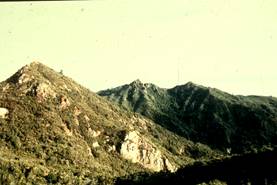 |
| Photo 28. Ridge forming ledges of barren high sulphidation alteration at Lookout Rocks dipping towards the Ohio Creek porphyry in the adjacent valley. |
Steam heated alteration occurs in the upper portions of high sulphidation epithermal systems, typically as laterally extensive sheets within the vadose zone above the palaeo water table, but also locally collapsing down structures. Oxidation of magmatic sulphur-bearing volatiles in this environment produces locally (moderately) acidic warm waters which react with host rocks. While massive low temperature silica is locally present, typically at the base close to the water table, most of this zone comprises friable rock characterised by opal, powdery alunite, kaolin and sulphur. This soft alteration mineralogy is only preserved in youthful poorly eroded systems such as in the arid portions of the high Andes (e.g., Pascua-Lama, Veladero, La Coipa). As a volatile-dominant low temperature alteration, cinnabar may be well developed, but gold-silver mineralisation is not expected, unless this alteration is telescoped (collapsed) upon earlier mineralisation. Acidic oxidizing waters collapsing down structures from the vadose zone may promote locally high grade mineralisation by mixing with rising pregnant magmatic fluids (e.g., Pierina, Veladero). Sulphur has been rarely mined from this alteration.
The challenge for explorationists has been to prospect for mineralised feeder structures at depth below laterally extensive sheets of texturally destructive barren steam heated alteration. Geological mapping should seek to identify breccia systems which form important fluid conduits in mineralised high sulphidation systems. It may be possible to project into an alteration zone from outside, structures which act as conduits for either rising mineralised fluids, or collapsing acid fluids as an aid to mineral deposition by fluid mixing.
Magmatic solfataras are recognised as the direct venting of high temperature magmatic volatiles to the surface within active magmatic arcs. These are characterised by silica-alunite-kaolin alteration near vents and deposition of locally significant quantities of sulphur production (e.g., Kawah Ijen, former production from Biliran and White Is.). Although recent studies (Hedenquist et al. 1993) suggest that some magmatic solfataras deposit metals they do not constitute major ore systems.
The term acid sulphate is now preferred for acid alteration formed by the reaction with host rocks of collapsing cool acidic condensate waters (Corbett and Leach, 1998), most notably in low sulphidation gold deposits including current geothermal systems (e.g., Waitapu, Photo 29; Lihir, Photo 30).
Mainly argillic alteration comprises low temperature silica (opal, cristobalite), pyrite, and kaolin with minor sulphur, and is termed advanced argillic alteration where alunite is also present.
Mineralised high sulphidation systems
Mineralised high sulphidation epithermal gold deposits predominantly occur in younger poorly eroded magmatic arcs (e.g., Andes of South America), although some are noted on the older arcs of eastern Australia (e.g., Gidginbung, Peak Hill). Thus, most occur in volcanic host rocks and demonstrate associations with subvolcanic intrusions, particularly flow dome complexes and are commonly localised by similar major structural corridors to those which host porphyry Cu-Au deposits, where more deeply eroded.
Fluid characteristics
High sulphidation deposits are typically derived from fluids enriched in magmatic volatiles, which have migrated from intrusion source rocks at depth, to elevated epithermal crustal settings, with only limited dilution by groundwaters or interaction with host rocks. Major dilatant structures or phreatomagmatic breccia pipes provide conduits for rapid fluid ascent and so facilitate evolution of the characteristic high sulphidation fluid. As the rapidly rising fluid becomes depressurised, magmatic volatiles (dominantly SO2 but also HCL, CO2, & HF) come out of solution and react with water (magmatic and groundwater) and oxygen to produce increasing concentrations of H2SO4. Under lower temperature conditions (<300°C) at elevated crustal settings (epithermal environments), dissociation produces hot acidic fluids (Corbett and Leach, 1998). Thus, sulphur occurs in a +4 state as SO2 in an oxidizing fluid. Characteristic zoned high sulphidation alteration (below) is derived from the progressive cooling and neutralization of the hot acidic fluid by interaction the with host rocks, typically at epithermal levels.
Field observations indicate that initial zoned alteration is overprinted by the deposition of sulphide ore and additional gangue minerals is accounted for in the two phase fluid flow model (White 1991; Corbett and Leach, 1998), in which this alteration results from the interaction with host rocks of the more rapidly migrating volatile rich-component of the high sulphidation fluid, while the subsequent liquid-rich component deposits sulphides and Au-Ag-Cu mineralisation.
Permeability
Dilatant structures or phreatomagmatic breccia pipes commonly provide conduits for the rapid introduction of hot acidic fluids into the epithermal environment where they react with host rocks to produce characteristic alteration. Most ore systems display elements of structural, breccia, or lithological control (Sillitoe, 1999; Corbett and Leach, 1998). In many instances structural controls predominate in the deeper portions and pass upwards to a lithological control. Dilatant subsidiary structures with angular relationships to major structural corridors host ore and facilitate rock reaction (e.g., El Indio, Mt Kasi, Peak Hill), while elsewhere permeable host rock lithologies may control fluid flow (e.g., Pierina, La Coipa, El Guanaco). At Maragorik, fluids which produced alteration are interpreted to pass from structures to permeable lithologies, but later mineralisation is only well developed at the intersection of structures and lithology (Corbett and Hayward, 1994).
Diatreme flow dome complexes are the most important breccia control (e.g. Pascua, Wafi, Yanacocha, Veladero, Photo 31), particularly at the contact between the diatreme and brecciated host rocks, although phreatic breccias are locally recognised (e.g., La Pepa, Tambo). Many deposits are associated with dome margins (e.g., Mt Kasi; Summitville, Gray and Coolbaugh, 1994). The rapid fluid depressurisation associated with violent diatreme eruptions facilitates dissociation of acid-bearing fluids resulting in initiation of high sulphidation alteration, and also provides important ground preparation. The intersection of dilatant structures and diatreme margins (e.g., Lepanto), or permeable horizons (e.g., Nena), represent ideal ore settings. Structural control commonly extends from major structural corridors which localise the ore system (e.g., Pascua-Lama-Veladero, Gidginbung), to dilatant ore-hosting fractures at outcrop scale (e.g., Mt Kasi). At Nena, a major dilatant structural corridor some 12 km long hosts several zones of high sulphidation alteration and controls the individual ore hosting dilatant fractures (Bainbridge et al., 1994; Corbett and Leach, 1998).
Alteration
High sulphidation ore systems are characterised by zoned alteration formed as a result of the progressive cooling and neutralization of the hot acidic fluids by reaction with host rocks and groundwaters (Corbett and Leach, 1998). At the core of high sulphidation ore systems hot acidic fluids leach many components from the host rocks leaving mainly only silica and some rutile, and so the altered rocks are termed residual silica or vughy silica, from the texture produced by the pseudomorphous removal of porphyritic feldspars and rock fragments (Photos 31 – 33). In many breccias finely comminuted rock material is replaced by massive fine grained silica, while porphyritic intrusion fragments display the characteristic vughy texture (Photo 31). Vughy silica provides important secondary permeability for later mineralisation.

Figure 5. Cross section through the Nena alteration system derived during the 1992 re-evaluation. Note the zoned alteration derived from a fluid flowing towards the viewer out of the page. Modified from Bainbridge et al., (1994) and Corbett and Leach (1998).
Mineralisation
Sulphide mineralisation is generally introduced after alteration into the central portion of the zonation by feeder structures or breccia pipes, and is characterised by sulphide assemblages dominated by pyrite and enargite (including low temperature polymorph luzonite), and lesser covellite (typically at deeper levels) and local, generally peripheral, tennantite-tetrahedrite (White and Hedenquist, 1995; Corbett and Leach, 1998; Sillitoe, 1999). While most high sulphidation systems are sulphide-rich where fresh, total sulphide content is not an indicator of this style of mineralisation. Many high sulphidation systems are mined in the weathered oxide ores in order to avoid difficult and hence higher cost sulphide metallurgy.
Ore textures are characterised by: filling of open space in the existing vughy silica (Photo 34), fissure veins within subsidiary dilatant structures, or matrix to breccias as: either permeable phreatomagmatic (Photo 35), phreatic breccias, open space expansion breccias in dilatant structural environments, or later sulphide matrix in syn-mineralisation fluid transport breccias, termed hydrothermal injection breccias in Corbett and Leach (1998). Barite and alunite gangue are commonly deposited with sulphides, and this constitutes a separate generation of alunite to that in the zoned alteration (Photo 36). Sulphur may be deposited at temperatures below 100°C late stage.
Vertical metal zonations are apparent as higher copper contents at deeper levels and greater abundances of gold or gold-silver along with local mercury, tellurium and antimony, in the upper portions of poorly eroded systems, or at the margins (Corbett and Leach, 1998).
Southwest Pacific high sulphidation systems are silver-poor while Andean systems may display Au:Ag ratios in the order of 1:100 (e.g., Pascua, La Coipa), and anomalous Pb and Zn are also locally recognised.
While most high sulphidation systems are characterised by gold grades in the 1-3.5 g/t range, some display remarkably higher gold grades attributed to fluid evolution and improved mechanisms of mineral deposition (Corbett, 2001a). These include:
- The change in elevated crustal settings to an ore fluid of a lower sulphidation style which might deposit later stage bonanza gold grades associated with mineralogies more typical of associations with mineralisation which might be regarded as epithermal quartz gold-silver style (e.g., El Indio; Jannas et al., 1990, 1999). Similarly, at the Link Zone of Wafi higher gold grades and improved metallurgy occur where the style of alteration and mineralisation demonstrates a progressive change from high to low sulphidation style (Leach, 1999).
- Mixing or rising pregnant fluids with oxidizing acid sulphate waters, typical of steam heated environments, may result in the deposition of elevated gold in association with hypogene oxidation, characterised by removal of sulphides and sulphur deposition (e.g., Pireina, Noble et al., 1997), or formation of hypogene jarosite rather than sulphides (e.g., Veladero).
Exploration implications
Most high sulphidation systems have been targeted from the recognition of outcropping alteration, commonly as landsat colour anomalies (e.g., Pascua, Veladero) or formerly evaluated for industrial purposes (e.g., Gidginbung, Peak Hill). Traditional stream prospecting in suitable terrains has identified alluvial gold and distinctive siliceous float (e.g., Wafi, Miwah) and abundant pyrite (e.g., Nena). Many high sulphidation systems display difficult metallurgy in sulphide ore (e.g., Wafi), and environmental difficulties associated with abundant pyrite or mercury.
Many exploration case histories (Corbett and Leach, 1998) now provide a basis to distinguish between mineralised and non-mineralised high sulphidation systems. Field mapping of alteration mineralogies and alteration zones is critical. Similarly, early field recognition of rock textures such as vughy silica allows exploration programs to focus upon high sulphidation characteristics. As field identification of fluid plumbing systems may vector towards higher grade ores, careful mapping of breccias can be of critical importance in targeting drill testing.
CONCLUSION
Styles of epithermal gold mineralisation are primarily distinguished between high and low sulphidation which evolve through dramatically differing fluid paths (Corbett and Leach, 1998). Low sulphidation mineralisation is further categorised, according to mineralogy, as styles formed at differing crustal levels, and according to relationships to possible magmatic source rocks, which relates to setting. Varying styles of acid alteration must be distinguished from mineralised high sulphidation alteration, which in turn display variations according to the level of formation and controls to permeability (structure, lithology, breccia).
Distinction between varying styles of epithermal gold mineralisation, identified from ore and gangue mineralogy, can be of significant benefit to the explorationist. During exploration some styles display supergene enrichment (quartz-sulphide gold + copper), while others are characterised by irregular gold distribution (carbonate-base metal gold) which must be taken into account during ore reserve calculation. Geophysical responses vary according to the style of mineralisation, while some systems such as enargite (high sulphidation) arsenical pyrite (low sulphidation) ores display difficult metallurgy.
Acknowledgements
The many colleagues, in particular Terry Leach, and clients who have assisted both during fieldwork and discussion are thanked for their generous support. Denese Oates lent her proof reading and drafting skills to my efforts. Andrew Waltho managed to get my offering into this electronic form.
References
Bainbridge, A.L., Corbett, G.J., and Leach, T.M., 1994, The Nena high sulphidation system, Frieda River Copper, Papua New Guinea, in Rogerson, R., ed., Geology, exploration and mining conference, June 1994, Lae, Papua New Guinea, proceedings: Parkville, The Australasian Institute of Mining and Metallurgy, p. 131-137.
Brathwaite, R.L., 1999, Hydrothermal fluid mixing and boiling in the Waihi epithermal silver-silver deposit, New Zealand in Mineral Deposits: Processes to Processing; Ed., C.J. Stanley, A.A. Balkema, Rotterdam p. 25-28.
Corbett, G. J., 2001a, Styles of epithermal gold-silver mineralisation: ProEXPLO 2001 Conference, Lima, Peru, published as CD.
Corbett, G.J., 2001b, Pacific rim Epithermal gold mineralisation: in Hancock, G., ed., Geology, exploration and mining conference, July 2001, Port Moresby, Papua New Guinea, Proceedings: Parkville, The Australasian Institute of Mining and Metallurgy, p. 56-68.
Corbett, in prep, Structure in porphyry Cu-Au and epithermal Au exploration: Applied Structural Geology Conference, Australian Institute of Geoscientists Kalgoorlie, September 2002.
Corbett, G.J., and Hayward, S.B., 1994, The Maragorik high sulphidation Cu/Au system – an update, in Rogerson, R., ed., Geology, exploration and mining conference, June 1994, Lae, Papua New Guinea, proceedings: Parkville, The Australasian Institute of Mining and Metallurgy, p. 125-129.
Corbett, G.J., and Leach, T.M., 1998, Southwest Pacific rim gold-copper systems: Structure, alteration and mineralisation: Economic Geology, Special Publication 6, 238 p., Society of Economic Geologists.
Corbett, G.J., Leach, T.M., Thirnbeck, M., Mori, W., Sione, T., Harry, K., Digan, K., and Petrie P., 1994, The geology of porphyry-related mesothermal vein gold mineralisation north of Kainantu, Papua New Guinea, in Rogerson, R., ed., Geology, exploration and mining conference, June 1994, Lae, Papua New Guinea, proceedings: Parkville, The Australasian Institute of Mining and Metallurgy, p. 113-124.
Corbett, G.J., Leach, T.M., Stewart, R., and Fulton, B., 1995, The Porgera gold deposit: Structure, alteration and mineralisation, in Pacific Rim Congress 95, 19-22 November 1995, Auckland, New Zealand, proceedings: Carlton South, The Australasian Institute of Mining and Metallurgy, p. 151-156.
Corbett, G., Hunt, S., Cook, A., Tamaduk, P., & Leach T., 2001, Geology of the Ladolam gold deposit, Lihir Island, from exposures in the Minifie open pit in Hancock, G., ed., Geology, exploration and mining conference, July 2001, Port Moresby, Papua New Guinea, Proceedings: Parkville, The Australasian Institute of Mining and Metallurgy, p. 69-78.
Gemuts, I., Little, M.L., and Giudici, J., 1996, Precious and base metal deposits in Argentina: SEG Newsletter No. 25, p. 1-14.
Gray, J.E. and Coolbaugh, M.F., Geology and Geochemistry of Summitville, Colorado: An Epithermal Acid Sulfate Deposit in a Volcanic Dome: Economic Geology, v. 89, p. 1906-1923.
Gustafson, L.B., and Hunt, J.P., 1975, The porphyry copper deposit at El Salvador, Chile: Economic Geology, v. 70, p. 857- 912.
Hawkins, M.A. and Akiro, A.K., Geology and exploration of the Irumafimpa (sic) Gold Project: in Hancock, G., ed., Geology, exploration and mining conference, July 2001, Port Moresby, Papua New Guinea, Proceedings: Parkville, The Australasian Institute of Mining and Metallurgy, p. 145-156.
Heald, P., Foley, N.K., and Hayba, D.O., 1987, Comparative anatomy of volcanic hosted epithermal deposits: acid-sulphate and adularia-sericite types: Economic Geology, v. 82, p. 1-26.
Hedenquist, J.W., Simmons, S.F., Giggenbach, W.F., and Eldridge, C.S., 1993, White Island, New Zealand, volcanic‑hydrothermal system represents the geochemical environment of high‑sulphidation Cu and Au ore deposition: Geology, v. 21, p. 731‑734.
Jannas, R.R., Beane, R.E., Ahler, B.A., and Brosnahan, D.R., 1990, Gold and copper mineralisation at the El Indio deposit, Chile, in Hedenquist, J.W., White, N.C., and Siddeley, G., eds., Epithermal gold mineralisation of the circum Pacific: Journal of Geochemical Exploration, v. 35, p. 197-232.
Jannas, R.R., Bowers, T.S., Petersen, U. and Beane, R.E., 1999, High-Sulphidation Deposit Types in the El Indio District, Chile in Geology and Ore Deposits of the Andes, Economic Geology Special Publication 7, Ed, B.J., Skinner, p. 219-266.
Kwak, T.A.P., 1990, Vein genesis, geochemical and flow controls on ore mineralisation at the Emperor Gold Mine, Vatukoula, Fiji, in Hedenquist, J.W., White, N.C. and Siddley, G., eds., Epithermal gold mineralisation of the Circum-Pacific: Geology, geochemistry, origin and exploration, II: Journal of Geochemical Exploration, v. 36, p. 297-337.
Leach, T.M., 1999, Evolution of selected porphyry copper-gold systems in the southwest Pacific region and its relevance to exploration in Pacrim ’99 Proceedings, Bali, Indonesia; The Australasian Institute of Mining and Metallurgy, Melbourne, p.211-225.
Leach, T.M., and Corbett, G.J., 1994, Porphyry-related carbonate base metal gold systems: Characteristics, in Rogerson, R., ed., Geology, exploration and mining conference, June 1994, Lae, Papua New Guinea, proceedings: Parkville, The Australasian Institute of Mining and Metallurgy, p. 84-91.
Leach, T.M., and Corbett, G.J., 1995, Characteristics of low sulphidation gold-copper systems in the southwest Pacific, in Pacific Rim Congress 95, 19-22 November 1995, Auckland, New Zealand, proceedings: Carlton South, The Australasian Institute of Mining and Metallurgy, p. 327-332.
Lindgren, W., 1922, A suggestion for the terminology of certain mineral deposits, Economic Geology, v. 17, p. 292-294.
Noble, D.C., Park-Li, B., Henderson, W.B., and Vidal, C.E., 1997. Hypogene oxidation and late deposition of precious metals in the Pierina high-sulphidation deposit and other volcanic and sedimentary rock-hosted gold systems: Sociedad Geologica del Peru, Volummen de Resumenes Extendidos, IX Congreso de Geologia, p. 121-127.
Sillitoe, R.H., 1995, Exploration of porphyry copper lithocaps, in Pacific Rim Congress 95, 19-22 November 1995, Auckland, New Zealand, proceedings: Carlton South, The Australasian Institute of Mining and Metallurgy, p. 527-532.
Sillitoe, R.H. 1999, Styles of High-Sulphidation Gold, Silver and Copper Mineralisation in Porphyry and Epithermal Environments in Pacrim ’99 Proceedings, Bali, Indonesia; The Australasian Institute of Mining and Metallurgy, Melbourne, p.29-45.
Simms, D., 2000, Controls on high grade gold distribution at Vera Nancy Mine: Northern Queensland Exploration and Mining 2000, Australian Institute of Geoscientists Bulletin 31, p. 51-60.
Stegman, C.L., 2001, Cobar Deposits: Still defying classification: SEG Newsletter No 44
Thompson, T.B., Tripple, A.D., and Dwelley, P.C., 1985, Mineralised veins and breccias of the Cripple Creek district, Colorado: Economic Geology, v. 80, p. 1669-1688.
White, N.C., 1991, High sulphidation epithermal gold deposits: characteristics and a model for their origin, in Matsuhisa, Y., Aoki, M., and Hedenquist, J.W., eds., High temperature acid fluids and associated alteration and mineralisation: Geological Survey of Japan Report, v. 277, p. 9-20.
White, N.C, and Hedenquist, J.W., 1995, Epithermal gold deposits: Styles, characteristics and exploration: SEG Newsletter, v. 23, p. 1, 9-13.
Received: Feb 2002
Published: April 2002
Copyright © The Australian Institute of Geoscientists, 2002

